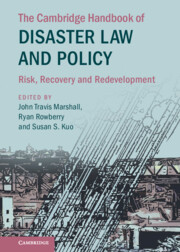Book contents
- The Cambridge Handbook of Disaster Law and Policy
- The Cambridge Handbook of Disaster Law and Policy
- Copyright page
- Dedication
- Contents
- Figures
- Maps
- Tables
- Contributors
- Foreword: Current Trends in Disaster Law and Policy
- Acknowledgments
- Introduction
- Part I Critical Perspectives on the Evolution of Disaster Law and Policy
- Part II Effective Governance as an Imperative for Responsive Disaster Law and Policy
- Part III Law’s Role in Promoting Hazard Mitigation: Intergovernmental, International, National, and Local Approaches
- 9 Local Resilience, Land Use Law, and Disaster Planning
- 10 Financing City Resilience
- 11 Disaster, Land Use, European Union Law and the Impact on EU Member States: The Relevance of the 2019 Decision of the Dutch Supreme Court Ordering Cuts in Greenhouse Gas Emissions
- 12 Covid-19 and Cooperation in Times of Disaster
- 13 Disaster Recovery in Rural Communities
- 14 Wildfire Federalism: A Framework for Local Government Participation in Disaster Planning
- 15 A Comparative Review of Hazard-Prone Housing Acquisition Laws, Policies, and Programs in the United States and Aotearoa New Zealand: Opportunities to Improve Practice
- 16 Urban Transformation as a Resilience Strategy: Earthquake Preparedness in Istanbul
- 17 How Do Green Cities Prevent Disasters?
- 18 Constructing a Resilient Energy Supply
- 19 Building a Resilient Power Grid
- 20 Weaponizing Private Property and the Chilling Effect of Regulatory Takings Jurisprudence in Combating Global Warming
- Part IV Private Sector Initiatives to Promote Disaster Resilience and Recovery
- Part V Lawyers As Disaster Law and Policy Leaders: Training for Students and Guidance for Practitioners
- Part VI Cultural Heritage Protection and Cross-Disciplinary Opportunities for Advancing Disaster Law and Policy
- Part VII Disasters and Vulnerable Communities
10 - Financing City Resilience
from Part III - Law’s Role in Promoting Hazard Mitigation: Intergovernmental, International, National, and Local Approaches
Published online by Cambridge University Press: 27 October 2022
- The Cambridge Handbook of Disaster Law and Policy
- The Cambridge Handbook of Disaster Law and Policy
- Copyright page
- Dedication
- Contents
- Figures
- Maps
- Tables
- Contributors
- Foreword: Current Trends in Disaster Law and Policy
- Acknowledgments
- Introduction
- Part I Critical Perspectives on the Evolution of Disaster Law and Policy
- Part II Effective Governance as an Imperative for Responsive Disaster Law and Policy
- Part III Law’s Role in Promoting Hazard Mitigation: Intergovernmental, International, National, and Local Approaches
- 9 Local Resilience, Land Use Law, and Disaster Planning
- 10 Financing City Resilience
- 11 Disaster, Land Use, European Union Law and the Impact on EU Member States: The Relevance of the 2019 Decision of the Dutch Supreme Court Ordering Cuts in Greenhouse Gas Emissions
- 12 Covid-19 and Cooperation in Times of Disaster
- 13 Disaster Recovery in Rural Communities
- 14 Wildfire Federalism: A Framework for Local Government Participation in Disaster Planning
- 15 A Comparative Review of Hazard-Prone Housing Acquisition Laws, Policies, and Programs in the United States and Aotearoa New Zealand: Opportunities to Improve Practice
- 16 Urban Transformation as a Resilience Strategy: Earthquake Preparedness in Istanbul
- 17 How Do Green Cities Prevent Disasters?
- 18 Constructing a Resilient Energy Supply
- 19 Building a Resilient Power Grid
- 20 Weaponizing Private Property and the Chilling Effect of Regulatory Takings Jurisprudence in Combating Global Warming
- Part IV Private Sector Initiatives to Promote Disaster Resilience and Recovery
- Part V Lawyers As Disaster Law and Policy Leaders: Training for Students and Guidance for Practitioners
- Part VI Cultural Heritage Protection and Cross-Disciplinary Opportunities for Advancing Disaster Law and Policy
- Part VII Disasters and Vulnerable Communities
Summary
Cities face formidable, if not existential, challenges as they manage hurricanes, wildfires, flooding, earthquakes, severe weather, and other kinds of disasters. Between 1980 and 2020, nearly 300 major events caused almost $2 trillion in damages in the United States. And it is getting worse. The average annual number of events costing more than $1 billion in damages rose from 2.9 during the 1980s to 13.5 during the 2010s, with increases occurring between every decade. Costs are rising as well, increasing by roughly one-half to nearly double between each successive decade. Humans play a key role in triggering disasters or making them worse, especially through climate change and altering landscapes. They can also act to lessen the effects of natural disasters on cities, though not eliminate them. This requires planning and financing. This chapter begins in Part I with an overview of the two generic kinds of disasters and why I focus on just one of them – the localized form. This will lead into Part II, which primarily addresses the role of local and regional governments to plan for disasters and their mitigation. It also outlines an economic and financial strategy to implement those plans. Existing tools to finance resilience investments are summarized in Part III. They include key federal tools and what I call “conventional” tools. Innovative and emerging tools focusing on capitalizing resilience savings and value-added are the focus of Part IV. I conclude with observations about the brave new world of financing city resilience.
Keywords
- Type
- Chapter
- Information
- The Cambridge Handbook of Disaster Law and PolicyRisk, Recovery, and Redevelopment, pp. 181 - 206Publisher: Cambridge University PressPrint publication year: 2022

